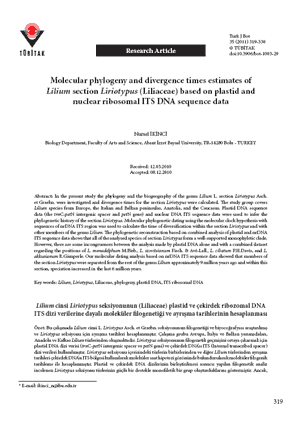NEWS 2011
Molecular phylogeny and divergence times estimates of Lilium section Liriotypus (Liliaceae) based on plastid and nuclear ribosomal ITS DNA sequence data
Nursel İKİNCİ
Turkish Journal of Botany 35(4): 319-330 (2011)
doi:10.3906/bot-1003-29
Biology Department, Faculty of Arts and Science, Abant İzzet Baysal University, TR-14280 Bolu, Turkey
Abstract
In the present study the phylogeny and the biogeography of the genus Lilium L. section Liriotypus Asch. et Graebn. were investigated and divergence times for the section Liriotypus were calculated. Th e study group covers Lilium species from Europe, the Italian and Balkan peninsulas, Anatolia, and the Caucasus. Plastid DNA sequence data (the trnC-petN intergenic spacer and petN gene) and nuclear DNA ITS sequence data were used to infer the phylogenetic history of the section Liriotypus. Molecular phylogenetic dating using the molecular clock hypothesis with sequences of nrDNA ITS region was used to calculate the time of diversifi cation within the section Liriotypus and with other members of the genus Lilium. The phylogenetic reconstruction based on combined analysis of plastid and nrDNA ITS sequence data shows that all of the analysed species of section Liriotypus form a well supported monophyletic clade. However, there are some incongruences between the analysis made by plastid DNA alone and with a combined dataset regarding the positions of L. monadelphum M.Bieb., L. szovitsianum Fisch. & Avé-Lall., L. ciliatum P.H.Davis, and L. akkusianum R.Gämperle. Our molecular dating analysis based on nrDNA ITS sequence data showed that members of the section Liriotypus were separated from the rest of the genus Lilium approximately 9 million years ago and within this section, speciation increased in the last 6 million years.
[The paper contains new divergence time estimates between Fritillaria and sister genera Lilium]

